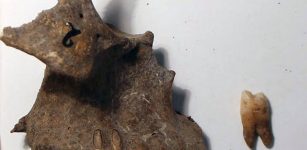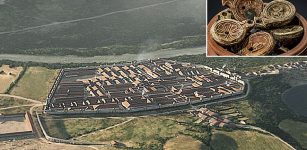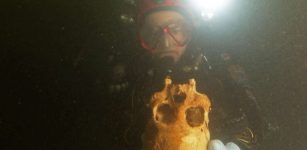Controversial Study Suggests First People Reached America Earlier Than 12,600 Years Ago Migrating Along The Pacific Coast
MessageToEagle.com – The most common and accepted theory is that the first people to reach the Americas crossed via an ancient land bridge between Siberia and Alaska about 12,600 years ago.
This theory has now been challenged by a new study that suggests America was populated much earlier than previously thought.
According to this new controversial study the first Americans, who were present south of the ice sheets long before 12,600 years ago, made the journey south by another route. The study’s authors suggest that they probably migrated along the Pacific coast.

Who these people were is still widely disputed. Archaeologists agree, however, that early inhabitants of the modern-day contiguous United States included the so-called “Clovis” culture, which first appear in the archaeological record over 13,000 years ago.
According to conventional wisdom, people had to wait until two huge ice sheets that covered what is now Canada started to recede, creating the so-called “ice-free corridor” which enabled them to move south.
See also:
People Who Predated Clovis Culture And Were Present In America Earlier Than Previously Thought
An international team of researchers, led by Professor Eske Willerslev, an evolutionary geneticist from Centre for GeoGenetics, University of Copenhagen and University of Cambridge used ancient DNA extracted from a crucial pinch-point within this corridor to investigate how its ecosystem evolved as the glaciers began to retreat. They created a comprehensive picture showing how and when different flora and fauna emerged and the once ice-covered landscape became a viable passageway.
The researchers conclude that while people may well have travelled this corridor after about 12,600 years ago, it would have been impassable earlier than that, as the corridor lacked crucial resources, such as wood for fuel and tools, and game animals which were essential to the hunter-gatherer lifestyle.

This means the first people to reach America earlier than 12,600 years ago must have come from a different place and the study’s authors suggest that they probably migrated along the Pacific coast.
“The bottom line is that even though the physical corridor was open by 13,000 years ago, it was several hundred years before it was possible to use it,” Willerslev said.
“That means that the first people entering what is now the US, Central and South America must have taken a different route. Whether you believe these people were Clovis, or someone else, they simply could not have come through the corridor, as long claimed.”
“The ice-free corridor was long considered the principal entry route for the first Americans. Our results reveal that it simply opened up too late for that to have been possible,” Mikkel Winther Pedersen, a PhD student at the Centre for GeoGenetics, University of Copenhagen said.
The corridor is thought to have been about 1,500 kilometres long, and emerged east of the Rocky Mountains 13,000 years ago in present-day western Canada, as two great ice sheets – the Cordilleran and Laurentide, retreated.
“What nobody has looked at is when the corridor became biologically viable,” Willerslev said. “When could they actually have survived the long and difficult journey through it?”
The conclusion reached by Willerslev and his colleagues is that the journey would have been impossible until about 12,600 years ago. Their research focused on a “bottleneck”, one of the last parts of the corridor to become ice-free, and now partly covered by Charlie Lake in British Columbia, and Spring Lake, Alberta – both part of Canada’s Peace River drainage basin.
MessageToEagle.com










